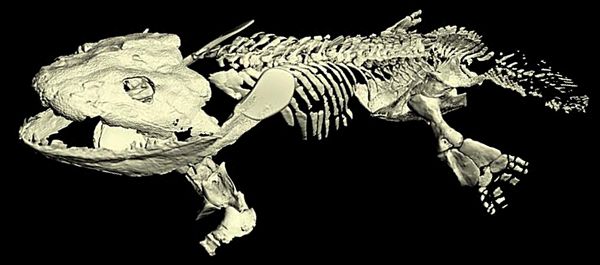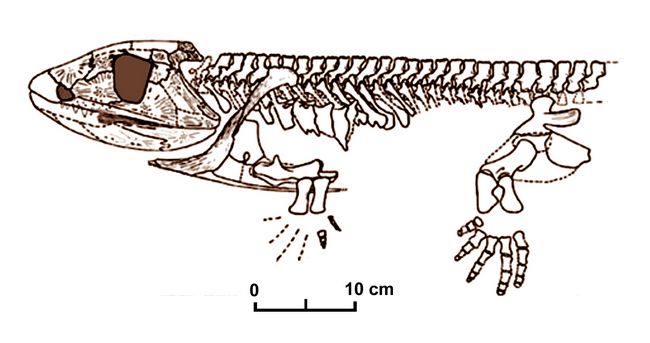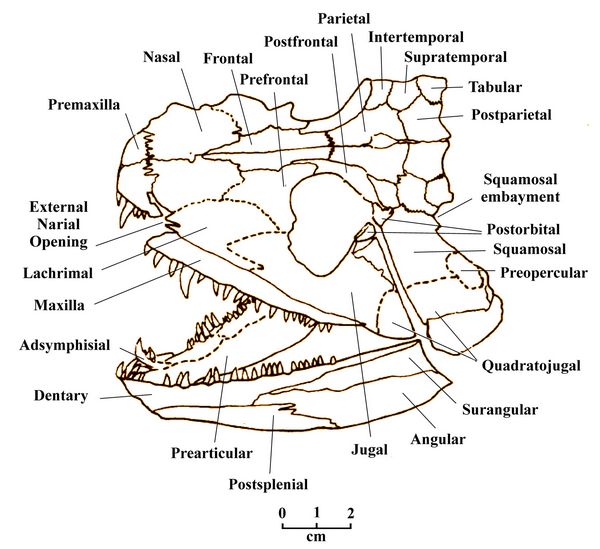Athena Review Vol. 5, no. 1
Records of Life: Fossils as Original Sources
12. Tetrapods
The term Tetrapoda is that of a superclass comprising the earliest vertebrates who lived on land, forming a transitional group between lobe finned fish and amphibians. They appeared at the end of the Devonian period, after about 375 mya (Clack 2012). This is distinct from the more generalized cladistic use of the term tetrapod, as a clade or branch which contains all land vertebrates, including modern taxa.
Ichthyostegalians.
The earliest landliving vertebrates were the Ichthyostegalia, an order of early tetrapods who are considered amphibians in the widest sense (sensu latu). Ichthyostegalians were relatively large, with adults up to a meter or more in length. Their flat, massive heads were filled with labyrinthodont teeth, used for carnivorous subsistence which presumably concentrated on fish as a staple. They probably also ate arthropods and other invertebrates living along tidal channels. Their vertebrae were complex and rather weak. At the close of the Devonian, forms with progressively stronger legs and vertebrae evolved, and the later groups lacked functional gills as adults. As adults, the animals would have been heavy and clumsy on land, and would probably appear more as fish that occasionally went ashore rather than proper land animals. All were however predominately aquatic and some spent all or nearly all their lives in water.
Combining these factors, the Ichthyostegalia comprises an order including the genera Ichthyostega, Acanthostega, Tulerpeton, and Elginerpeton, the most basal of tetrapods which have toes rather than fins. This includes all taxa more advanced than Tiktaalik, the tetrapodomorph lobe finned fish considered as the closest relative of tetrapods known to have retained paired fins rather than feet (Coates and Clack 1990).
In cladistic terms, this group is considered an evolutionary grade rather than a clade; in other words, it contains a mixture of descent groups, and is not monophyletic. While all members of the group had limbs or feet rather than fins, most, if not all, had internal gills in adulthood and lived primarily as shallow water fish and spent minimal time on land. They all had labyrinthodont teeth with infolded dentine and enamel layers, a trait which persisted in most early amphibians through the Mississippian period.
The Ichthyostegalia evolved during the Early to Middle Devonian from Tetrapodomorph fish in the order Elpistostegalia, similar to but earlier than Panderichthys or Tiktaalik. They successfully colonized swampland and tidal channels or coastal rivers throughout the Devonian period. The Ichthyostegalia gave rise to the amphibian order called Temnospondyli, and then disappeared at the transition to the Mississippian period, when a major extinction event occurred at the end of the Devonian (ca. 360-359 mya), reflected in a scarcity of fossil evidence known as Romer's Gap, after the paleontologist Alfred Romer (1956)..
The first Ichthyostegalia emerged in the fossil record at about 375 mya, during the Late Devonian period. Two of the most completely studied are Ichthyostega and Acanthostega, both found in Greenland.
Ichthyostega
Ichthyostega (Greek: "fish roof", referring to armored skull bones; see below for “Stegocephalian”) was an early tetrapod genus from the end of the Upper Devonian (374 – 359 mya). It was one of the first tetrapods known in the fossil record. Ichthyostega (fig.1) was first described in 1932 by Gunnar Save-Soderbergh, who named five species from a collection of 14 fossil specimens collected the previous year in Late Devonian rock strata by the Danish East Greenland Expedition. Additional specimens were collected between 1933 and 1955. The species were distinguished on the basis of skull proportions and skull bone patterns (Jarvik 1996).
Ichthyostega was at first seen as transitional between fish and the early Stegocephalians (a term meaning “roofed head”, coined in 1868 by Edward Drinker Cope for large amounts of dermal armor on the skulls of early amphibians; and which became the name of another paryphyletic or mixed group). Ichthyostega combines such a flat, heavily armoured stegocephalian skull with a fishlike tail bearing fin-rays. Later work on Ichthyostega and
 other Devonian Labyrinthodonts
shows that they also had more than 5 digits to each foot (e.g.,
Acanthostega has 8 digits), with the whole foot being somewhat
fin-like. Acanthostega (“spiky roof”), later found in the same East
Greenland locations as Ichthyostega, also appears to have had a soft
operculum (gill plate, which in amphibians changed into a pectoral
bone), and both it and Ichthyostega possessed functional internal gills
as adults.
other Devonian Labyrinthodonts
shows that they also had more than 5 digits to each foot (e.g.,
Acanthostega has 8 digits), with the whole foot being somewhat
fin-like. Acanthostega (“spiky roof”), later found in the same East
Greenland locations as Ichthyostega, also appears to have had a soft
operculum (gill plate, which in amphibians changed into a pectoral
bone), and both it and Ichthyostega possessed functional internal gills
as adults. Fig.1: 3-D Model of Ichthyostega (after Clack et al. 2012).
Ichthyostega shows a fully transitional form between fish and amphibians, combining a fishlike tail and gills with an amphibian skull and limbs. Ichthyostega was a labyrinthodont, with air-breathing lungs and flexible, muscular limbs that helped it navigate through shallow water in swamps. Although undoubtedly of amphibian build and habit, however, it is not considered a true member of the group in the narrow sense, as the first true amphibians appeared in the Mississppian period.
Acanthostega
The closely-related genus Acanthostega (fig.2) was first found in East Greenland in 1933 by Gunnar Save-Soderberg and Eric Jarvik, in the same Late Devonian rock formation that had yielded Ichthyostega fossils. Acanthostega means "spiny roof" (acantho- "spiny; -stega "roof") , referring to its skull features; gunnari stands for one of the discoverors. In 1987 Jennifer Clack found and published more complete examples in the same East Greenland formation. These show that Acanthostega had well-developed limbs, with an unusual array of 8 digits on its hands and feet.
 Acanthostega, descended from lobe finned fish, was mainly
adapted to life in the water. It retained a fish-like shoulder, while
its Tetrapod (amphibian-like) features included a humerus, radius, and
ulna. It
had a middle ear with a stapes that was used as part of a kind of
spiracle for respiration, rather than as an ossicle in hearing as the
stapes later became used in reptiles and synapsids. Like Ichthyostega, Acanthostega also had functional internal gills as adults.
Acanthostega, descended from lobe finned fish, was mainly
adapted to life in the water. It retained a fish-like shoulder, while
its Tetrapod (amphibian-like) features included a humerus, radius, and
ulna. It
had a middle ear with a stapes that was used as part of a kind of
spiracle for respiration, rather than as an ossicle in hearing as the
stapes later became used in reptiles and synapsids. Like Ichthyostega, Acanthostega also had functional internal gills as adults. Fig.2: Acanthostega skull (AMNH cast)
Ichthyostega's skull seems more fish-like than that of Acanthostega, but its shoulder and hip girdles appear more robust and better adapted to movement on land. Ichthyostega also had more supportive ribs and stronger vertebrae, with more developed process (called zygaophyses) for rib attachment. All of this strongly indicates that Ichthyostega sometimes walked on land.
Romer's Gap
"Romer's Gap" is named for the paleontologist Alfred Romer (1956), who described a discontinuity in the fossil record between vertebrates at the end of the Devonian period, with its high diversity of fishes, and low density of fossil assemblages of both fish and tetrapods in the early Carboniferous (Mississippian period). Romer's gap (ca. 360-335 mya) corresponds to the last few million years of the Devonian period, and the first 15-20 million years of the Mississippian (Tournaisian and Visean stages).
Several lines of evidence tend to confirm Romer's observations. A major extinction event at the end of the Devonian reduced most surviving marine and freshwater groups to a few lineages. Before the event, oceans and lakes were dominated by lobe-finned fishes and armored fishes called placoderms. After the gap, modern ray finned fish, as well as sharks and their relatives, became the dominant forms. The period also saw the demise of the Ichthyostegalia, early fish-like tetrapods with more than five digits, named for the type genus Ichthyostega (Coates et al. 2008).
Evidence for a sharp reduction in marine fishes at the start of Romer's Gap is also seen in an equivalent rise, during the same period, in hard-shelled crinoid echinoderms which were previously the chief prey of shell-crushing predator fish. When the number of shell-crushing ray-finned fishes and sharks increased later in the Carboniferous, coincident with the end of Romer's gap, the diversity of crinoids with Devonian-type protective shells fell sharply (Kammer and Ausitch 2006).
Several recent finds of early tetrapods including Pederpes and Whatcheeria from the period 347-340 mya have helped fill in this gap.
Pederpes

Pederpes finneyae ("Peter's Foot") is an early Carboniferous tetrapod in the Stegocephalian order, dating from 348-347 mya in the Tournaisian stage of the Lower Mississippian Period. Discovered in 1971 in the Ballagan Formation of the Inverclyde Group in central Scotland as a nearly complete skeleton, it was initially classed as a lobe-finned fish. In 2002, the fossil was reclassified as a tetrapod by Jennifer Clack (2002), who notes its importance as occurring in the "Romer's Gap" interval.
Fig.3 Skeleton of Pederpes finneyae (after Clack 2002).
Pederpes (fig.3) was about 1 meter long and had a large, roughly triangular head, similar to that of the slightly later early tetrapod Whatcheeria deltae from Iowa, from which it is distinguished only by a few minor skull and skeleton features. Pederpes is the earliest tetrapod to show feet which face forward and are thus adapted to terrestrial locomotion, as distinguished from the paddle-like feet of the Late Devonian Ichthyostegalia. The ear structure of Pederpes shows its hearing faculties were still more oriented to underwater sound, indicating it looked there for food.
Whatcheeria
Whatcheeria deltae (fig.4) was a primitive tetrapod dating from the Mississippian period (340 mya), found in Delta Quarry, Iowa by M.P. McAdams. The genus is named after What Cheer, Iowa, the home town of the discoverer, while the species is named for the find site. W. deltae belongs to the phylum Chordata, the class Sarcopterygii (lobe-finned fish), the superclass Tetrapoda, and the family Whatcheeriidae.
 The
holotype (FM PR 1871700, at the Field Museum of Natural History in
Chicago) is a skull with presacral vertebral column, a partial shoulder
girdle, ribs, and a partial hindlimb. Over 200 other tetrapods have
also been recovered from the same site.
The
holotype (FM PR 1871700, at the Field Museum of Natural History in
Chicago) is a skull with presacral vertebral column, a partial shoulder
girdle, ribs, and a partial hindlimb. Over 200 other tetrapods have
also been recovered from the same site. Fig.4: Skull of Whatcheeria deltae (after Lombard and Bold 1995)
Whatcheeria shows a mixture of sarcoptygerian (lobe-finned fish-like) and tetrapod (early amphibian) traits. The skull retains a number of primitive characters, such as the preopercular bone, and some characters of the lower jaw, which are lost in later tetrapods. The skull is 200-250 mm long, with a large parietial foramen, a Meckelian foramen on the lower jaw, a cleithrum, and an array of large, recurved teeth.
The body length was 1 m. Expanded ribs found in the thoracic region of the trunk are somewhat reminiscent of those of Ichthyostega, and flattened, paddlelike limbs are reminiscent of both Ichthyostega and Acanthostega. Along with the limb bones are at least 5 digits.
References:
Benton, M.J. 2004. Vertebrate Paleontology. Blackwell Publishers
Blom, H. 2005. Taxonomic Revision Of The Late Devonian Tetrapod Ichthyostega from East Greenland. Palaeontology, 48; Part 1:111–134
Carroll, R. L. 1988. Vertebrate Paleontology and Evolution, WH Freeman & Co.
Chang & Smith 1992
Clack, J. A. 2002. An early tetrapod from "Romer's Gap". Nature. 418 (6893): 72–76.
Clack, J.A. 2012. Gaining Ground. University of Indiana Press.
Clack, J.A. et al. 2012. A computerized rendering of Ichthyostega showing limbs in active positions. Nature.
Coates, M. I. and Clack, J. A. 1990. Polydactyly in the earliest known tetrapod limbs". Nature 347: 66–67.
Coates, M.I. et al. 2008.
Janvier 1996
Jarvik, E. 1980
Jarvik, E 1996 . "The Devonian tetrapod Ichthyostega". Fossils & Strata 40: 1–213.)
Kammer and Ausitch 2006
Laurin et al. 2007
Lombard; R.E. and J.R. Bolt; 1995. A New Primitive Tetrapod, Whatcheeria Deltae, from the Carboniferous of Iowa. Paleontology vol 38 (3); pp.471-494.;
Long 1995
Romer, A.S. 1956. The early evolution of land vertebrates. Proceedings of the American Philosophical Society, 100 (3) : 151-167.
Säve-Söderbergh, G. 1932. Preliminary note on Devonian stegocephalians from East Greenland. Meddelelser om Gr¢nland, 94(7), pp.1-107..
Schultze and Trueb 1991
Smithson, T. R.; Wood, S. P.; Marshall, J. E. A.; Clack, J. A. 2012. Earliest Carboniferous tetrapod and arthropod faunas from Scotland populate Romer's Gap. Proceedings of the National Academy of Sciences. 109 (12): 4532–4537.
Glossary